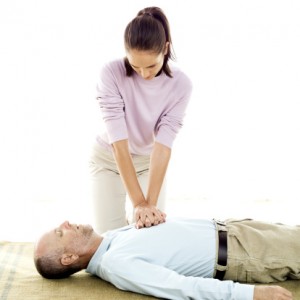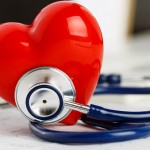First aid steps to help heart attack victims at home
 By recognizing the symptoms of a heart attack you can increase your chance of survival. Each year, roughly 70,000 Canadians have a heart attack – that’s one heart attack every seven minutes. And every 10 minutes, someone has a stroke.
By recognizing the symptoms of a heart attack you can increase your chance of survival. Each year, roughly 70,000 Canadians have a heart attack – that’s one heart attack every seven minutes. And every 10 minutes, someone has a stroke.
In fact, heart disease and stroke are two of the top three leading causes of death in Canada and the leading cause of hospitalization.
You may think you have nothing to worry about, but consider this: 90 percent of Canadians are at risk of contracting heart disease or having a stroke.
If you smoke, abuse alcohol, avoid exercise, are obese, have diabetes, high blood pressure and/or high cholesterol you are part of that 90 percent. This is why heart attack and stroke prevention are critical.
Warning signs of a heart attack
The Heart and Stroke Foundation of Canada lists these heart attack symptoms for both men and women:
- Sudden discomfort or pain that does not go away with rest
- Pain in the chest, neck, jaw, shoulder, arms or back
- Pain that feels like burning, squeezing, heaviness, tightness or pressure
- Chest pain or discomfort that is brought on with exertion and goes away with rest
- Shortness of breath and/or difficulty breathing
- Nausea, indigestion and/or vomiting
- Sweating, cool/clammy skin, fear, anxiety and denial
First aid for heart attack
If someone – or even yourself – has displayed the warning signs of a heart attack, follow the below tips in order to offer them first aid.
- Call 911 immediately – the operator may advise you to administer an aspirin or walk you through chest compressions.
- Sit or lie down while waiting for the ambulance and loosen any tight clothing.
- Stay calm.
- Administer nitroglycerin if available as it opens up blood vessels.
If you are having a heart attack
- Time is of the essence. If you are experiencing any of the above heart attack symptoms, do not wait; call 911 immediately. If you hesitate, it may be too late to prevent permanent heart damage.
- Do not ask someone to drive you to the hospital, unless you have no other choice.
- If you experience heart attack symptoms when you’re alone in your car, pull over immediately and call 911. If you don’t have a cell phone, flag down another motorist.
- Try your best not to panic by taking long, deep breaths. When the 911 dispatcher answers, simply say: “I think I’m having a heart attack.”
- You may be told to chew and swallow an aspirin, or if you’re already under a doctor’s care for heart disease, you may be told to place a nitroglycerin pill under your tongue.
- If, while waiting for the ambulance, you feel faint or dizzy, unlock your door and lie down on the floor where emergency responders can see you when they arrive.
Stroke warning signs
 When having a stroke, part of the blood supply to your brain is cut off, causing your brain cells to die, which can result in disability or death.
When having a stroke, part of the blood supply to your brain is cut off, causing your brain cells to die, which can result in disability or death.
The American Stroke Association lists these stroke symptoms:
- Sudden numbness or weakness of the face, arm or leg, especially on one side of the body
- Sudden confusion, trouble speaking or understanding
- Sudden trouble seeing in one or both eyes
- Sudden trouble walking, dizziness, loss of balance or coordination
- Sudden, severe headache with no known cause
If you are having a stroke
- Call 911 immediately.
- Check the time. When did your stroke symptoms first appear? A clot-busting drug called tissue plasminogen activator (tPA) can reduce long-term disability if it is administered within three hours of the start of your stroke symptoms.
Life after heart attack, heart attack prevention
 Medications and lifestyle factors play a critical role in heart attack prevention and recovery.
Medications and lifestyle factors play a critical role in heart attack prevention and recovery.
According to the Mayo Clinic, if you’ve already had a heart attack or are at high risk for one, most doctors will prescribe a daily blood thinner such as acetylsalicylic acid (aspirin). And if you are undergoing an angioplasty or stent procedure, you’ll probably be prescribed an anti-clotting drug, such as clopidogrel (Plavix).
Other heart attack prevention medications include: beta blockers, which lower your heart rate and blood pressure; angiotensin-converting enzyme (ACE) inhibitors, which allow blood to flow from your heart more easily; and medications to lower your cholesterol.
Lifestyle changes are also part of a heart attack prevention program. To keep heart attacks at bay: don’t smoke, remain physically active, eat healthy foods, maintain a healthy weight and manage your stress levels.
Stroke Prevention
Like heart attack prevention, you can reduce your risk of having a stroke by not smoking, losing weight, exercising more and consuming less alcohol.
Low-dose aspirin can reduce risk of heart attack and stroke for people in their 50s
American experts in preventative medicine now suggest low-dose aspirin is a means to lower the risk of heart attack and stroke for people in their 50s. Furthermore, individuals in their 60s can also reduce their risk of heart attack and stroke by taking low-dose aspirin, but it may not benefit them as much as those in their 50s. Continue reading…
-
8 Weight Loss Tips For Eating Out
It seems when a person goes out to eat all their rules for dieting
-
YoYo Dieting Dangerous Weight Loss
What Is Yo-Yo Dieting?Yo-yo dieting is a term that is becoming all too
-
Weight Loss Vacations For A Trim New Lifestyle?
Weight loss vacations are becoming increasingly popular in our rotund
-
The Numerous Advantages Of Finding The Perfect Solution To Dieting
For lots of people, the very word ‘diet’ is unappealing. A
-
3 Day Diet Make Believe Diet Plans
The 3 day diet mixes certain types of foods that supposedly react in a
-
Losing Weight: The Best Healthy Breakfast Choices
With obesity becoming such a widespread problem, everyone has to st
- DON'T MISS
- The Weight Loss Mind
- How To Affect Your Subconscious Mind Using Subliminal Technology
- Emotional Eaters: Old Habits Die Hard, But You Can Get Over Them!
- Sugar High: Diabetes The Killer Disease
- Avoid Sagging Skin after Weight Loss
- Low Carb Diet Ideas - Tips And Tricks To Lose the Weight
- Fat Loss Secrets: Short Term Goals to Achieve Long Term Success
- Return to Fat Camp Weight Loss Back in MTV
- Tips To Lose Weight Which You Can Start Right Now
- Healthy Diet Plan Is The Key To Fast Fat And Weight Loss




